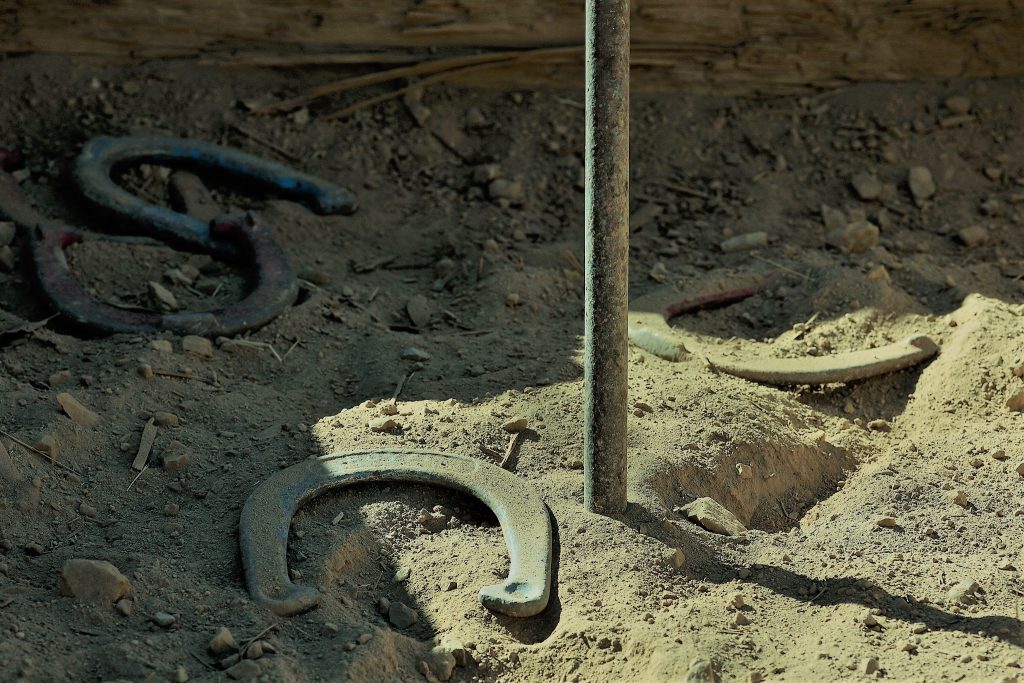Let’s Play Horseshoes! Posted by Gary Locke on May 24, 2018 in Culture
One of the great American traditions for the summer is gathering friends and family for some backyard games. Every family has its favorites, and there’s no better way to spend a warm afternoon than to share some laughs and get a little exercise at the same time. We might play ball games such as bocce ball or volleyball, or maybe a game of croquet or badminton. Few of these pastimes seem quite as rooted in our Colonial past, however, as an old-fashioned game of horseshoes. This summer, why not try a game that’s been played in this land since before George Washington?
The Basics
In simplest terms, the game of horseshoes is played by tossing, or pitching, a horseshoe 40 feet at a spike embedded into a sand pit. Points are awarded for closest distance to the spike, with more points awarded if the horseshoe encircles the spike, called a ringer. If it sounds easy, don’t be misled.
The game didn’t originate in the United States, but it certainly has become a permanent fixture of our summers. It is remarkably similar to quoits, which is very popular in Great Britain. They both probably are variations of games from ancient Greece and Rome. When the Romans settled in Britain, they would have brought their games with them. It likely began as a test of strength, tossing a disc or horseshoe as far as possible. At some unrecorded time, the addition of the spike turned a contest of might into a game of skill.
Quoits is played by tossing a metal or rope (or plastic) ring at a spike or pin. It is easily played indoors and is enjoyed by many British pub-goers. Horseshoes, however, can only be played outdoors. Official horseshoe courts measure 6 feet wide by 46 feet long, with a 3×4-foot sand or gravel pit at each end. The spikes at the center of each pit should be set to tilt ever so slightly toward each other, and at a straight line. You should also establish a foul line perimeter of three feet in front of each spike. The pitcher’s feet must remain inside that foul line when a horseshoe is tossed, or the toss is nullified. The simplicity of the set-up makes this such an ideal backyard game. Apart from the stakes, the only other equipment needed will be the horseshoes.
Backyard Rules
Players commonly pitch their horseshoes underhanded, but some will fling their horseshoes with a twist of the wrist. Official rules forbid this technique, but friendly games may not be so strict in their enforcement of all rules. Frankly, an underhand pitch allows most players a better ability to aim the horseshoe by sighting the spike inside the U of the horseshoe.
- The game is divided into innings, like baseball, with each player allowed two horseshoes per inning.
- An agreed upon number of innings, along with the number of points required for a win, should be established by the players before each game. I also suggest a minimum of a two-point advantage for the winner in order to avoid disputes.
- Only one player scores in an inning, with only the closest horseshoe scoring.
- A horseshoe can only score if it rests 6 inches or less from the stake.
- The horseshoe closest to the stake scores one point.
- Ringers each score three points, but if both players throw ringers, the throws cancel each other out.
Of course, a game is only fun if everybody is enjoying it. Play to win, but be a good sport in the process.

Build vocabulary, practice pronunciation, and more with Transparent Language Online. Available anytime, anywhere, on any device.




